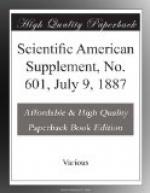In this arrangement there is the simplicity of genius. He gets a fine cotton fabric woven into the shape of a cylinder, with a tapering point. In its first stage it is about 2 inches in diameter; and after being coated with the composition, it is subjected to a strong heat. This has two effects—first, the cotton fiber is completely burned out, while the composition retains the shape of the woven surface on which it was moulded. Then the cylinder contracts and solidifies until it becomes about the size of the forefinger of a glove. Dr. Welsbach calls this his “mantle;” and by a simple arrangement he fits it on a Bunsen burner, and places an ordinary lamp chimney over it. When the flame is applied, the “mantle” becomes incandescent, and gives out a brilliant yellow light, which, it may be said without exaggeration, will compare favorably with any electric light yet put on the market.
For decorative effect a pretty frosted globe is used; and by varying the globe a pure white or a pure yellow may be obtained. It is also added that there is no act of Parliament required for it, nor even a provisional order of the Board of Trade. No streets have to be broken up in order to lay down pipes; and no wires have to be hung across the roofs of protesting householders.
The whole apparatus can be got ready to fit on an ordinary gas bracket; and two or three spare frames with “mantles” can be kept in the house in case of accident. Whoever sees the Welsbach incandescent light in operation will readily admit that it is the “coming light.” It has beauty, brilliancy, purity, and economy all on its side.
Let us hope (added the chairman) this description is not overdrawn; but of this you will later on have an opportunity of judging for yourselves. No doubt the general or even partial adoption of this light would have a tendency to reduce the consumption of gas, as a smaller quantity would be required to produce the same amount of illumination. Nevertheless, gas engineers will hail it with approval if it in any way tends to popularize the use of gas, and helps to increase the comfort and improve the sanitation of our houses, churches, halls, etc. Moreover, gas is continually being adopted for fresh purposes; and we can confidently look forward to an almost unlimited field in the rapid and ever increasing use of gas as a fuel and for cooking purposes, as well as for motive power. The new and really excellent gas engines now being brought into the market will, no doubt, create a healthy rivalry, and tend to cheapen these useful machines, and so bring them within the reach of many persons who have hitherto been prevented from employing them by their considerable first cost.
PARAFFIN AS A RIVAL OF COAL GAS.
But while the day has gone by when any one of us fears the electric light as a possible rival, we are not insensible to the fact that paraffin oil, from its present low-price, is a rival which we cannot afford to despise. And more especially is this the case in many of the smaller towns and villages, where the charge for gas is of necessity higher than in the larger towns.




